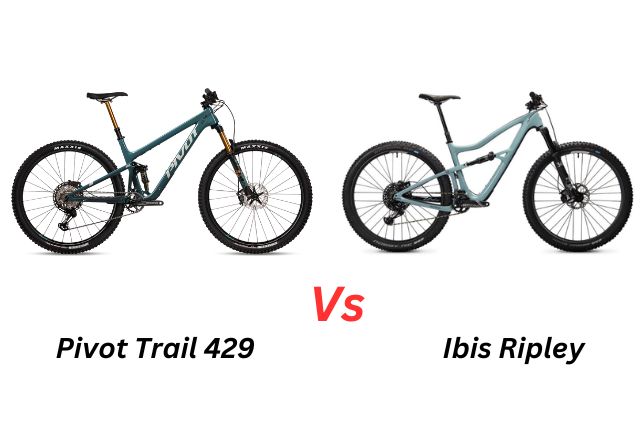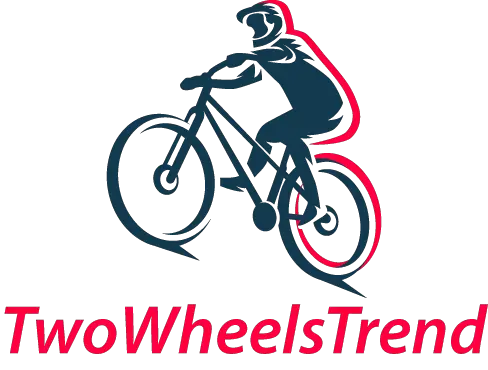
The Pivot Trail 429 and the Ibis Ripley are among the best in the market, offering a balanced blend of efficiency, agility, and fun. But how do they compare to each other, and which one is right for you?
Here, we will compare the Pivot Trail 429 and the Ibis Ripley in terms of their geometry, suspension, components, performance, and price.
Geometry
The Pivot Trail 429 and the Ibis Ripley have similar geometry numbers, but there are some subtle differences that affect their handling and feel. Both bikes have a 66.5-degree head tube angle, a 75.5-degree seat tube angle, and a 44mm fork offset.
However, the Pivot Trail 429 has a slightly longer reach (460mm vs 450mm in size large), a slightly shorter chainstay (430mm vs 432mm), and a slightly lower bottom bracket height (337mm vs 339mm).
The Ibis Ripley has a longer wheelbase (1201mm vs 1197mm in size large), a higher stack height (618mm vs 611mm), and a steeper effective seat tube angle (76.2 degrees vs 75.9 degrees).
These differences shows that the Pivot Trail 429 feels more stable at high speeds and more responsive in tight corners, while the Ibis Ripley feels more nimble and playful on jumps and drops.
The Pivot Trail 429 also has more room to move around on the bike, while the Ibis Ripley has a more upright and comfortable riding position.
Suspension
Both bikes use a dw-link suspension design, which is known for its excellent pedaling efficiency and traction. However, they have different amounts of travel and shock tunes.
Rear Travel
The Pivot Trail 429 has 120mm of rear travel and 130mm of front travel, while the Ibis Ripley has 120mm of rear travel and 140mm of front travel.
Shock
The Pivot Trail 429 uses a Fox Float DPS shock with a custom tune that is firmer in the mid-stroke for better support and pop, while the Ibis Ripley uses a Fox Float DPS shock with a lighter tune that is more supple in the initial stroke for better small bump sensitivity.
The Pivot Trail 429 has more mid-stroke support and pop, while the Ibis Ripley has more small bump sensitivity and front-end grip. The Pivot Trail 429 is better suited for smoother trails and faster riders who like to pump and jump, while the Ibis Ripley is better suited for rougher trails and slower riders who like to soak up bumps and drops.
Read Also: Stumpjumper Alloy vs. Comp Alloy: Compared
Components
Both bikes come with high-end components that are reliable and durable. However, they have different drivetrains, brakes, wheels, tires, and dropper posts.
Drivetrain
The Pivot Trail 429 comes with a Shimano XT/XTR drivetrain that offers smooth shifting and crisp performance, while the Ibis Ripley comes with a SRAM XX1 AXS drivetrain that offers wireless shifting and light weight.
Brakes
The Pivot Trail 429 comes with Shimano XT brakes that offer powerful stopping power and modulation, while the Ibis Ripley comes with SRAM Code RSC brakes that offer more adjustability and bite.
Wheels
The Pivot Trail 429 comes with DT Swiss M1700 wheels that are stiff and strong, while the Ibis Ripley comes with Industry Nine Enduro S Hydra wheels that are lighter and faster-engaging.
Tires
The Pivot Trail 429 comes with Maxxis Minion DHF/DHR II tires that offer excellent grip and durability, while the Ibis Ripley comes with Schwalbe Hans Dampf/Nobby Nic tires that offer more speed and comfort.
Dropper Post
The Pivot Trail 429 comes with a Fox Transfer dropper post that is smooth and reliable, while the Ibis Ripley comes with a RockShox Reverb AXS dropper post that is wireless and easy to use.
According to the above differences, the Pivot Trail 429 has more reliable shifting and braking performance, while the Ibis Ripley has more lightweight and innovative components.
The Pivot Trail 429 also has more aggressive tires that suit rougher terrain, while the Ibis Ripley has more efficient tires that suit smoother terrain.
Read Also: Salsa Rangefinder vs. Timberjack: Compared
Performance
Both bikes perform exceptionally well on the trails, offering a fun and efficient ride quality. However, they have different strengths and weaknesses depending on the terrain and riding style.
The Pivot Trail 429 is faster on smooth trails, climbs better on steep sections,and handles better on tight corners. The Ibis Ripley is smoother on rough trails, descends better on technical sections, and feels more playful on jumps and drops.
The Pivot Trail 429 is more stable and responsive, while the Ibis Ripley is more nimble and playful.
Price
Both bikes are expensive, but they offer a lot of value for the money. The Pivot Trail 429 costs $7500, while the Ibis Ripley costs $8200. The Pivot Trail 429 offers a more balanced and versatile bike that can handle any trail, while the Ibis Ripley offers a more specialized and innovative bike that can excel on certain trails. The Pivot Trail 429 is more affordable, while the Ibis Ripley is more premium.
Conclusion
The Pivot Trail 429 and the Ibis Ripley are both excellent trail bikes that offer a lot of fun and performance. However, they have different characteristics that suit different riders and preferences.
The Pivot Trail 429 is more stable, responsive, and efficient, while the Ibis Ripley is more nimble, playful, and smooth. The Pivot Trail 429 is better for smoother trails and faster riders, while the Ibis Ripley is better for rougher trails and slower riders. The Pivot Trail 429 is more affordable, while the Ibis Ripley is more premium.
Ultimately, the best bike for you depends on your riding style, terrain, and budget.
